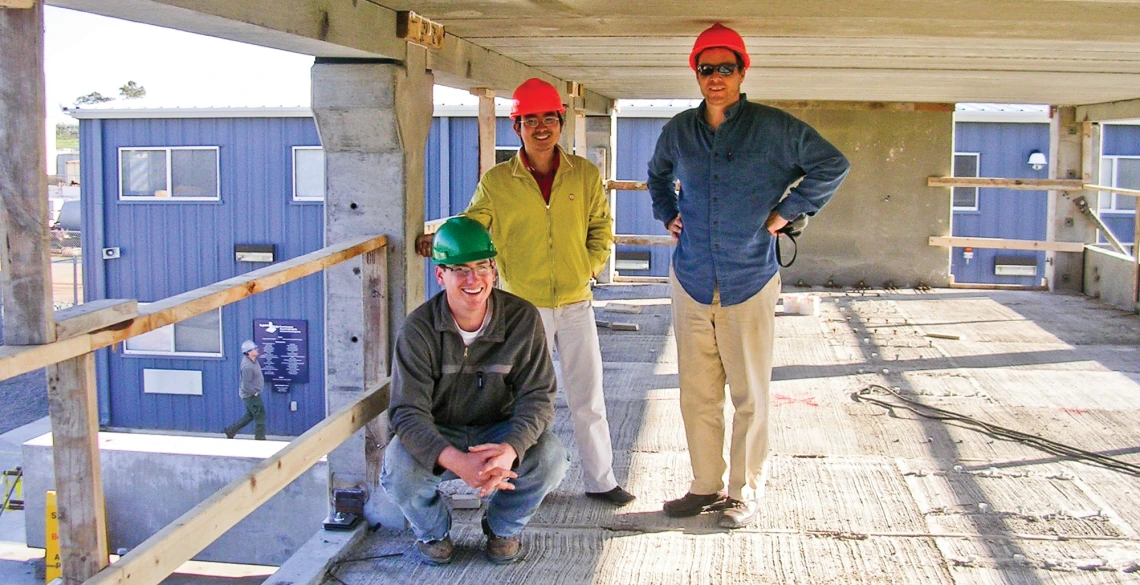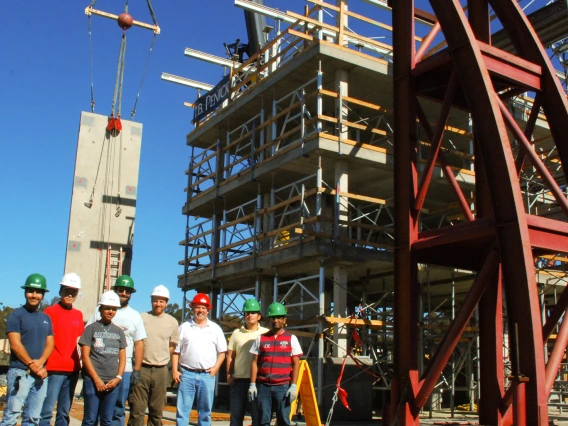Expanded Concrete Curriculum to Pilot Spring 2018
PCI Foundation grant gives future engineers and architects a solid footing in precast/prestressed concrete.

Doctoral students Matt Schoettler of UCSD, left, and Dichuan Zhang of UA, center, and professor Robert Fleischman, right, inspect the second floor of the 500-ton concrete test parking structure at the Englekirk Structural Engineering Center.
The Precast/Prestressed Concrete Institute Foundation awarded a grant of $85,000 over four years for the University of Arizona to develop new curriculum focusing on precast and prestressed concrete. The curriculum, called the UA PCI Studio, will be integrated throughout the civil engineering, architecture and architectural engineering programs.
Robert Fleischman, a professor in the Department of Civil Engineering and Engineering Mechanics, is principal investigator for the project. Ray Barnes, a lecturer in the College of Architecture, Planning and Landscape Architecture, is coordinating the architecture portion of the PCI Studio effort.
What Is Precast? What Is Prestressed?
Precast concrete has been poured into a reusable mold, cured and then taken to a construction site and put in place, as opposed to standard, or cast-in-place concrete, which is poured into forms and cured on site.
Prestressed concrete is precast in the plant around high-strength steel wires that act like rubber bands to squeeze the concrete to high levels of compression, making it stronger and better able to support the weight of an actual structure: Concrete is 10 times stronger under compression than under tension.
Precast and prestressed concrete are highly specialized areas, so many students don’t learn about them in school -- Fleischman himself said he didn’t know the first thing about precast until after he finished his doctorate. But now UA students will have the opportunity to study these fields as undergraduates.
Concrete in the Classroom
The PCI studio, piloting in Spring 2018, will include modules on prestressed element design, precast building anatomy, concrete highway bridge girder construction, architectural precast, and sustainability. Two new lab modules will also be introduced. When students in the architectural engineering program become seniors, they will participate in an integrated architectural studio/capstone design of a total precast structure as a part of PCI Studio.
Outside the classroom, PCI Studio will involve a national seminar series, student projects, field trips and internships. Coreslab Structures in Phoenix, which is serving as the industry champion for PCI Studio by coordinating industry involvement with the program, has already provided internships for two UA undergraduates, Dalton Thorpe and Erik Christensen.
Thorpe and Christensen are also leading a group of six undergraduates in the PCI Studio to compete in the PCI Big Beam student competition, in which student teams will build and test a 22-foot precast/prestressed beam.
“They’re two of our best students, and now, instead of graduating knowing nothing about precast, they’ve actually worked at a precast plant,” Fleischman said.
Marty McIntyre, executive director of the PCI Foundation, said one of the reasons Fleischman’s proposal was selected for funding was its interdisciplinary approach.
“It better reflects how the industry works, because nobody really works in a vacuum, especially when you’re building real projects,” she said. “We try to get the students out of the classroom and into the precast plant and onto construction sites.”
Dawn Rogers, a member of the Coreslab business development team, said that Coreslab already recruits students from the College of Engineering. Helping to familiarize UA students -- and potential future Coreslab employees -- with precast or prestressed concrete is a win-win, she said.
“Precast is a very niche market,” she said. “The fact that students have learned about it and know that precast is an option is huge.”
Why Precast? Why Prestressed?
Fleischman explained precast/prestressed is the preferred method for exposed structures, like parking structures and stadiums, because cracks can’t open to let in moisture, making it more effective at resisting corrosion. In addition, it makes for a much quieter, faster construction process. A building that might otherwise take six months to complete can be completed in 10 weeks with precast. Casting concrete in a factory also allows for more modularity and quality control than doing it on site.
In the past, precast often wasn’t considered for use in high seismic areas simply because it’s so specialized. But in recent years, researchers have developed precast designs that allow the joints between blocks of concrete to open and close freely. This ability to resist earthquake damage gives precast buildings another important advantage over traditional concrete.
“Some of these precast buildings have performed really well in other countries,” Fleischman said. “We’re seeing undamaged precast hospital buildings, whereas the cast-in-place concrete building a few blocks away collapsed.”
Means and Methods
Industry professionals, including UA alumni Ted Buell, structures section manager for the Tucson office of HDR, and Dave Zaleski, bridge engineer for the Pima County Department of Transportation, will provide seminars, precast plant tours, construction site visits and potential internships for PCI Studio students.
“With the PCI grant, they’re going to get experience even before they graduate,” Zaleski said. “This is going to give them the opportunity to be prepared for their profession.”
Dean Papajohn, associate professor of practice in the College of Engineering, said that his part in the program will involve both classroom instruction and trips to local construction sites. It supports his goal of connecting students with engineers in both academia and the public sector.
“We have great faculty and industry partners, and it’s fun to find new ways to take advantage of the skills, knowledge and resources everyone has to offer,” he said.


